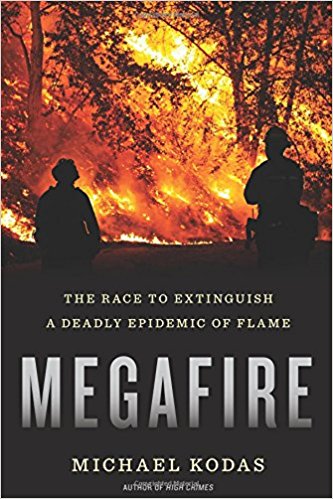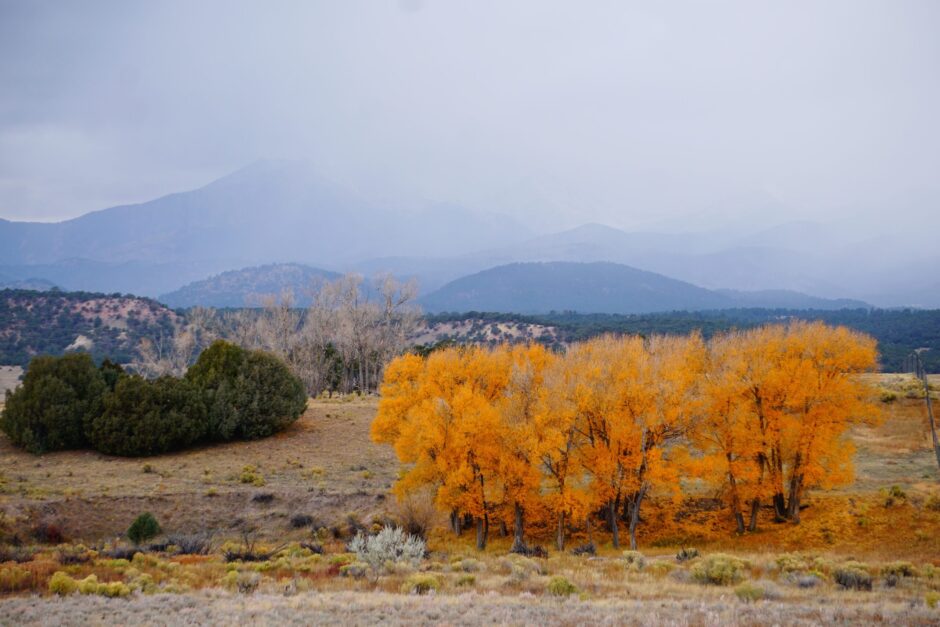So after having owned a home in Custer County, Colorado (Go Wildcats!) for fifteen years and having been a frequent visitor to the Rockies since 1978—the year of my first trip to Yellowstone—I’m both fascinated by and have a fear of forest fires. In 1988, the infamous year when most of Yellowstone National Park was burning—the park was closed, a half-million acres burned, or about two-thirds of the park—I was backpacking in the Wind River mountains of Wyoming, south of Yellowstone: I remember once hiking to the top of a ridge to watch the alpenglow on nearby peaks, and seeing flaming trees on a ridge not too many miles distant. At the time I wasn’t very worried, considering the fire to be too far away; since the winds were light and not blowing in our direction, we thought the flames were actually rather pretty. How naive I was. That was then: Now my feeling is more like the tagline from the old Jeff Goldblum film The Fly: “Be afraid. Be very afraid.”
Why the change of heart? I recently read Michael Kodas’s new book of nonfiction, Megafire: The Race to Extinguish a Deadly Epidemic of Flame (2017), for one thing. But the thirty years that have elapsed since my afternoon on a mountainside in Wyoming have been the grand time of Climate Change, and things are considerably worse now than they were before: more heat, more fuel, more catastrophe. This winter, for instance, southern Colorado is in a serious snow drought, and if relief doesn’t come in the spring (which of course we all hope for) the conditions will be rife for another wicked fire season.
Simply put, Megafire is an excellent and at times frightening book. Kodas describes the causes and particulars of fires throughout the West, from Texas to California and Idaho, and features several Colorado fires in great detail, including the Four-Mile Canyon Fire and the Waldo Canyon Fire of 2012 (which burned several hundred homes in Colorado Springs). Overall he presents the idea that our forest service policy of fire suppression has led to hotter, larger fires, and the popularity of homes in the mountains (like mine!) makes the public at more danger than ever before. The scariest passages describe how fast a fire can move and “blow up,” most often triggered by high winds, which sometimes shift unexpectedly. I’ll give the book this praise: It’s changed my thinking about forest fires. They are common in the West and I’ve been driving by them, and choking on their smoke and ash, for years, but after reading descriptions of people surrounded by fire with no escape route, I’ll be extra careful next time I encounter one. The Yarnell Hill Fire of Arizona (July of 2013) frames the book, as begins with a description of its aftermath, and then ends the book with a description of exactly how it happened, and how nineteen firefighters of the Granite Mountain Hotshots died. It’s a sobering story, and one that deserves to be told, and read. You feel for the firefighters, and for their families.
Unfortunately, politically things have also gotten worse: It’s an outrage and a travesty what the Trump administration has done to the EPA—in only one year!—and Trump’s ridiculous assertion that Climate Change is a “hoax” serves as a reminder to the triumph of stupidity in the 21st century, our so-called Information Age. That Trump seems not only to ignore but to be actively hostile to West, the part of the U.S. most vulnerable to the blistering effects of Climate Change, is an additional embarrassment and shame. I’m glad that Michael Kodas has written Megafire, a kind of wake-up call for protection of our western forests.

- October 2023
- September 2023
- September 2021
- April 2020
- September 2019
- May 2019
- August 2018
- February 2018
- January 2018
- October 2017
- August 2017
- June 2017
- May 2017
- March 2017
- February 2017
- November 2016
- October 2016
- May 2016
- April 2016
- March 2016
- February 2016
- January 2016
- November 2015
- October 2015
- September 2015
- June 2015
- May 2015
- April 2015
- March 2015
- December 2014
- September 2014
- August 2014
- May 2014
- March 2014
- February 2014
- January 2014
- December 2013
- November 2013
- October 2013
- September 2013
- August 2013
- July 2013
- June 2013
- May 2013
- April 2013
- March 2013
- February 2013
- January 2013
- December 2012
- November 2012
- October 2012
- September 2012
- August 2012
- July 2012
- June 2012
- May 2012
- April 2012
- March 2012
- February 2012
- January 2012
- December 2011
- November 2011
- October 2011
- September 2011
- August 2011
- July 2011
- June 2011
- May 2011
- April 2011
- March 2011
- February 2011
- January 2011
- December 2010
- November 2010
- October 2010
- September 2010
- August 2010
- July 2010
- June 2010
- May 2010
- April 2010
- March 2010
- February 2010
- January 2010
- December 2009
- November 2009
- October 2009
- September 2009
- August 2009
- July 2009
- June 2009
- May 2009
- April 2009
- March 2009
Recent Posts
- Aliens Among Us: Probing Hillbillies and Freaking Shut-ins, How Netflix’s “Encounters” and Hulu’s “No One Will Save You” Prep Us for the Coming Alien Apocalypse, Kind of
- My Life as a Bob Odenkirk Character: On How Watching Netflix’s Black Mirror episode “Joan Is Awful” Mimicked My Experience of Watching the AMC series Lucky Hank
- “Bobcats, Bobcats, Bobcats”: Animal Life and a Tribute to “Modern Family”
- “The North Water”: This Ain’t Your Daddy’s Moby Dick
- Day 25: On David Quammen's "Spillover": Terrific Book That Foretold Our Pandemic, Kind of
Recent Comments
No comments to show.
